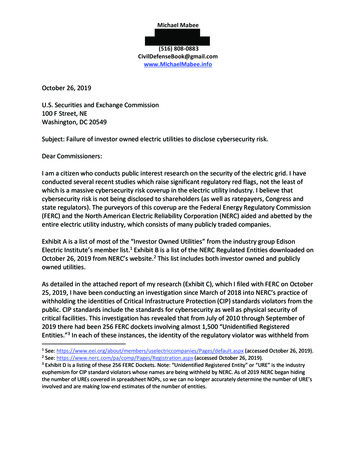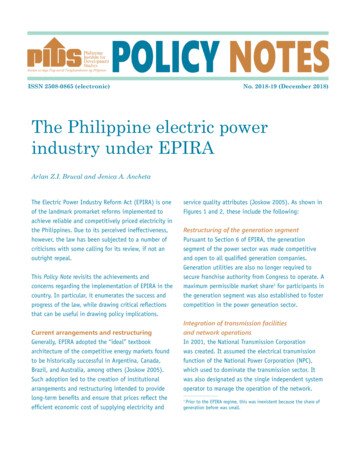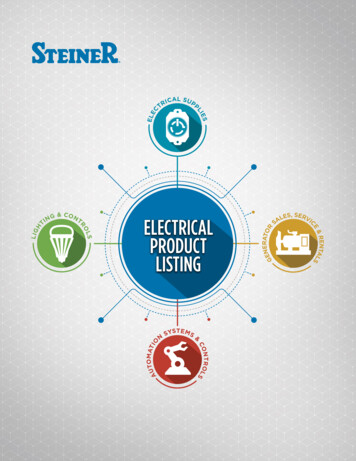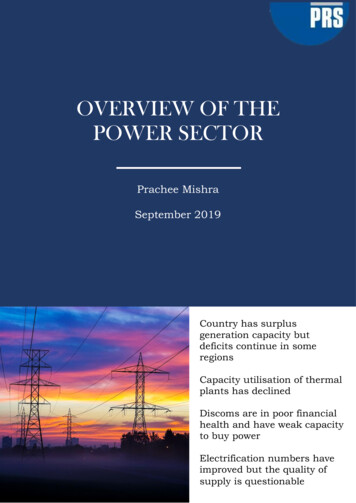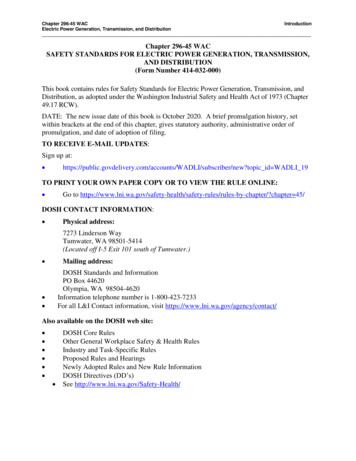
Transcription
Chapter 296-45 WACIntroductionElectric Power Generation, Transmission, and DistributionChapter 296-45 WACSAFETY STANDARDS FOR ELECTRIC POWER GENERATION, TRANSMISSION,AND DISTRIBUTION(Form Number 414-032-000)This book contains rules for Safety Standards for Electric Power Generation, Transmission, andDistribution, as adopted under the Washington Industrial Safety and Health Act of 1973 (Chapter49.17 RCW).DATE: The new issue date of this book is October 2020. A brief promulgation history, setwithin brackets at the end of this chapter, gives statutory authority, administrative order ofpromulgation, and date of adoption of filing.TO RECEIVE E-MAIL UPDATES:Sign up at: criber/new?topic id WADLI 19TO PRINT YOUR OWN PAPER COPY OR TO VIEW THE RULE ONLINE: Go to rules-by-chapter/?chapter 45/DOSH CONTACT INFORMATION: Physical address:7273 Linderson WayTumwater, WA 98501-5414(Located off I-5 Exit 101 south of Tumwater.) Mailing address:DOSH Standards and InformationPO Box 44620Olympia, WA 98504-4620Information telephone number is 1-800-423-7233For all L&I Contact information, visit https://www.lni.wa.gov/agency/contact/ Also available on the DOSH web site: DOSH Core RulesOther General Workplace Safety & Health RulesIndustry and Task-Specific RulesProposed Rules and HearingsNewly Adopted Rules and New Rule InformationDOSH Directives (DD’s)See http://www.lni.wa.gov/Safety-Health/
Chapter 296-45 WACTable of ContentsElectric Power Generation, Transmission, and DistributionChapter 296-45 WACELECTRIC POWER GENERATION, TRANSMISSION, ANDDISTRIBUTIONWAC 296-45-005 Electrical workers safety rules-Foreword. . 1WAC 296-45-015 Scope and application. . 2WAC 296-45-025 Variances. . 5WAC 296-45-035 Definitions . 6WAC 296-45-045 NESC applicable. . 15WAC 296-45-055 Employer's responsibility. . 16WAC 296-45-065 Training. . 17WAC 296-45-067 Information transfer. . 19WAC 296-45-075 Employer's safety program. . 21WAC 296-45-085 Leadworker's responsibility. . 22WAC 296-45-095 Leadworker-employee responsibility. . 23WAC 296-45-105 Work required of leadworkers. . 24WAC 296-45-115 Employee's responsibility. . 25WAC 296-45-125 Medical services and first aid. . 26WAC 296-45-135 Job briefing. . 27WAC 296-45-175 Hazardous energy control (lockout/tagout) procedures. . 28WAC 296-45-17505 Lockout/tagout (hazardous control) program. . 28WAC 296-45-17510 Retraining. . 30WAC 296-45-17515 Protective materials and hardware. . 31WAC 296-45-17520 Energy isolation. 31WAC 296-45-17525 Notification. . 32WAC 296-45-17530 Lockout/tagout application. . 32WAC 296-45-17535 Releasing stored energy. . 32WAC 296-45-17540 Release from lockout/tagout. . 33WAC 296-45-17545 Temporary removal of lockout/tagout. . 33WAC 296-45-17550 Group lockout/tagout. . 34WAC 296-45-17555 Shift changes. . 34WAC 296-45-17560 Outside servicing personnel. . 34WAC 296-45-17565 Central system operator. . 34Page i
Chapter 296-45 WACTable of ContentsElectric Power Generation, Transmission, and DistributionWAC 296-45-195 Trenching and excavation. . 36WAC 296-45-205 Enclosed spaces. . 37WAC 296-45-215 Underground electrical installations. . 40WAC 296-45-225 Underground residential distribution (URD). . 43WAC 296-45-255 Protective equipment. . 45WAC 296-45-25505 Personal protective equipment. . 46WAC 296-45-25510 Fall protection. . 46WAC 296-45-275 Ladders, platforms, and manhole steps. . 52WAC 296-45-285 Hand and portable powered tools. . 54WAC 296-45-295 Gasoline engine power chain saws. . 56WAC 296-45-305 Live line tools. 58WAC 296-45-315 Materials handling and storage. . 60WAC 296-45-325 Working on or near exposed energized parts. . 61WAC 296-45-335 Deenergizing lines and equipment for employee protection. . 69WAC 296-45-345 Grounding for the protection of employees. . 72WAC 296-45-355 Underground grounding. . 74WAC 296-45-365 Testing and test facilities. . 75WAC 296-45-375 Mechanical equipment, including aerial manlift equipment. . 78WAC 296-45-385 Overhead lines. . 82WAC 296-45-455 Line-clearance tree-trimming operations. . 86WAC 296-45-45505 Brush chippers. . 87WAC 296-45-45510 Sprayers and related equipment. . 87WAC 296-45-45515 Stump cutters. . 87WAC 296-45-45520 Backpack power units for use in pruning and clearing. . 87WAC 296-45-45525 Rope. . 87WAC 296-45-45530 Fall protection. . 88WAC 296-45-465 Communication facilities. . 89WAC 296-45-475 Substations. . 90WAC 296-45-485 Power generation. . 93WAC 296-45-48505 Interlocks and other safety devices. . 93WAC 296-45-48510 Changing brushes. . 93WAC 296-45-48515 Access and working space. . 93WAC 296-45-48520 Guarding of rooms containing electric supply equipment. . 93Page ii
Chapter 296-45 WACTable of ContentsElectric Power Generation, Transmission, and DistributionWAC 296-45-48525 Guarding of energized parts. . 94WAC 296-45-48530 Water or steam spaces. . 95WAC 296-45-48535 Chemical cleaning of boilers and pressure vessels. . 95WAC 296-45-48540 Chlorine systems. 95WAC 296-45-48545 Boilers. . 96WAC 296-45-48550 Turbine generators. . 96WAC 296-45-48555 Coal and ash handling. . 96WAC 296-45-48560 Hydroplants and equipment. . 98WAC 296-45-525 Special conditions. . 99WAC 296-45-52505 Capacitors. . 99WAC 296-45-52510 Current transformer secondaries. 99WAC 296-45-52515 Series streetlighting. . 99WAC 296-45-52520 Illumination. . 99WAC 296-45-52525 Protection against drowning. . 99WAC 296-45-52530 Employee protection in public work areas. . 100WAC 296-45-52535 Backfeed. . 100WAC 296-45-52540 Lasers. . 100WAC 296-45-52545 Hydraulic fluids. 100WAC 296-45-52550 Foreign attachments and placards. . 100WAC 296-45-545 Trolley maintenance, jumpering or bypassing. . 101WAC 296-45-675 Rotorcraft/helicopter for power distribution and transmissionline installation, construction and repair--Scope. . 103WAC 296-45-67503 Definitions. . 103WAC 296-45-67504 Operating certification. . 104WAC 296-45-67506 Personnel. . 104WAC 296-45-67508 Hazard analysis and job briefing. 104WAC 296-45-67513 Personal protective equipment (PPE). . 105WAC 296-45-67515 Wearing apparel. 105WAC 296-45-67517 Loose gear and objects. . 106WAC 296-45-67519 Landing zones. . 106WAC 296-45-67521 Pilot’s responsibility. . 106WAC 296-45-67522 Cargo Hooks. . 106WAC 296-45-67523 Hooking and unhooking loads. . 107Page iii
Chapter 296-45 WACTable of ContentsElectric Power Generation, Transmission, and DistributionWAC 296-45-67525 Static charge. . 107WAC 296-45-67527 Line stringing. . 107WAC 296-45-67529 Visibility. . 108WAC 296-45-67531 Communication. . 108WAC 296-45-67533 Helicopter operation. . 109WAC 296-45-67536 Helicopter work tasks. . 109WAC 296-45-67537 Sling and rigging. . 111WAC 296-45-67541 Fires. . 111WAC 296-45-67545 Refueling operations. . 111WAC 296-45-900 Appendices. Nonmandatory. . 113WAC 296-45-902 Appendix A--Working on exposed energized parts. 113WAC 296-45-903 Appendix B--Protection from step and touch potentials—Nonmandatory . 132WAC 296-45-905 Appendix C--Methods of inspecting and testing wood poles-Nonmandatory . 149WAC 296-45-906 Appendix D--Protection from flames and electric arcs-Nonmandatory. . 145WAC 296-45-907 Appendix E--Work-positioning equipment inspection guidelinesNonmandatory. . 156WAC 296-45-908 Appendix F--Other Applicable safety and health Washingtonadministrative codes. . 157WAC 296-45-909 Appendix G--Flow chart--Nonmandatory. . 159WAC 296-45-910 Appendix H--Reference documents. . 160Page iv
Chapter 296-45 WACElectric Power Generation, Transmission, and DistributionWAC 296-45-005 Electrical workers safety rules-Foreword.The purpose of this chapter is to make the workplace of electrical employees as free fromrecognized hazards as reasonably possible. Following these rules may sometimes require thatemployee safety receive a higher priority than speed and work performance. These rules exist toprovide employee safety, so employees are expected, in good faith, to follow the provisions of thischapter. This chapter is not intended to be a complete job description nor is it expected that thechapter covers every hazard that an employee may encounter. When a hazard exists that is notcovered by this chapter, the leadworker and employees are expected, in good faith, to mutuallydiscuss the hazard and agree how to perform the work with the greatest degree of safety.The department of labor and industries is the sole and paramount administrative agency responsiblefor the administration and interpretation of this chapter and the Washington Industrial Safety andHealth Act of 1973. If there exists a question as to the meaning of any provision of this chapter,such question must first be directed to the department of labor and industries and its authorizedrepresentatives.Experience has proven that the majority of injuries and deaths are preventable. Most injuries anddeaths are not due to defective equipment but are due to failure on the part of the employees andthose in authority to observe safety rules and failure to use safety devices. In the last analysis, thischapter is a compilation of experience and common sense. Electrical safety requires that the workbe properly planned, executed by the use of good judgment and under the direction of intelligentsupervision.Page 1
Chapter 296-45 WACElectric Power Generation, Transmission, and DistributionWAC 296-45-015 Scope and application.(1)This chapter covers the operation, maintenance, and construction of electric powergeneration, control, transformation, transmission, and distribution lines and equipment.These provisions apply to:(a)Power generation, transmission, and distribution installations, including relatedequipment for the purpose of communication or metering, which are accessibleonly to qualified electrical employees;Note: The types of installations covered by this chapter include the generation,transmission, and distribution installations of electric utilities, as well asequivalent installations of industrial establishments. Trolley maintenance,jumpering, and bypass is also covered by this chapter. Supplementaryelectric generating equipment that is used to supply a workplace foremergency, standby, or similar purposes only is covered under Part L ofchapter 296-24 WAC and WAC 296-800-280.(b)(2)Other installations at an electric power generating station, as follows:(i)Fuel and ash handling and processing installations, such as coal conveyors;(ii)Water and steam installations, such as penstocks, pipelines, and tanks,providing a source of energy for electric generators; and(iii)Chlorine and hydrogen systems.(c)Test sites where electrical testing involving temporary measurements associatedwith electric power generation, transmission, and distribution is performed inlaboratories, in the field, in substations, and on lines, as opposed to metering,relaying, and routine line work;(d)Work on or directly associated with the installations covered in subsections (1)(a)through (c) of this section; and(e)Line-clearance tree-trimming operations, as follows:(i)This chapter except WAC 296-45-455, applies to line-clearance treetrimming operations performed by qualified electrical employees (those whoare knowledgeable in the construction and operation of electric powergeneration, transmission, or distribution equipment involved, along with theassociated hazards).(ii)WAC 296-45-065, 296-45-067, 296-45-125, 296-45-135, 296-45-255, 29645-315, 296-45-375, and 296-45-455 through 296-45-45530 apply to lineclearance tree-trimming operations performed by line-clearance treetrimmers who are not qualified electrical employees.Notwithstanding subsection (1) of this section, this chapter does not apply to electricalinstallations, electrical safety-related work practices, or electrical maintenanceconsiderations covered by Part L of chapter 296-24 WAC and WAC 296-800-280.Page 2
Chapter 296-45 WACElectric Power Generation, Transmission, and DistributionNote 1: Work practices conforming to WAC 296-24-970 through 296-24-985 areconsidered as complying with the electrical safety-related work practicerequirements of this chapter, provided the work is being performed on ageneration or distribution installation meeting WAC 296-24-95601through 296-24-95699. This chapter also applies to work by qualifiedelectrical employees directly on or associated with installations of electricpower generation, transmission, and distribution lines or equipment,regardless of compliance with WAC 296-24-970 through 296-24-985.Note 2:Work practices performed by qualified electrical employees andconforming to this chapter are considered as complying with WAC 29624-95601 through 296-24-95699.(3)This section applies in addition to all other applicable safety and health standardsadministered by the department. Specific references in this section to other standards areprovided for emphasis only.(4)Operation, conditions, work methods and other work related situations or activities notspecifically covered by this chapter are subject to the rules and regulations of chapter 296-24WAC General safety and health standards; chapter 296-27 WAC Recordkeeping andreporting; chapter 296-32-WAC Safety standards for telecommunications; chapter 296-62WAC General occupational health standards; chapter 296-155 WAC Safety standards forconstruction work; chapter 296-800 WAC Safety and health core rules; and, insofar asapplicable to employee safety and health, chapter 19.29 RCW. Additionally, operations,conditions, work methods and other work related situations or activities may be subject toadditional rules and regulations depending upon the nature of the work being performed.(5)These rules do not apply to the use of existing electrical installations during their lifetime,provided they are maintained in good condition and in accordance with the applicable safetyfactor requirements and the rules in effect at the time they were installed, and provided thatreconstruction conforms to the rules as herein provided.(6)Any rule, regulation or standard contained within this chapter, if subject to interpretation,must be interpreted to achieve employee safety, which is the ultimate purpose of thischapter.(7)Should a rule or standard contained within this chapter conflict, in any manner, with astandard or rule contained within any other chapter of Title 296 WAC the standard or rulecontained herein applies so long as the work being done is power generation, transmission,and distribution installations, including related equipment for the purpose of communicationor metering, which are accessible only to qualified electrical employees. If there are ruleswithin this chapter that conflict, the rule that provides the greatest employee safety willapply.(8)Neither the promulgation of these rules, nor anything contained in these rules will beconstrued as affecting the relative status or civil rights or liabilities between employers andtheir employees and/or the employees of others and/or the public generally; nor will the useherein of the words “duty” and “responsibility” or either, import or imply liability other thanprovided for in the industrial insurance and safety laws of the state of Washington, to anyPage 3
Chapter 296-45 WACElectric Power Generation, Transmission, and Distributionperson for injuries due to negligence predicated upon failure to perform or discharge anysuch “duty” or “responsibility,” but failure on the part of the employees, leadworker, oremployer to comply with any compulsory rule may be cause for the department of labor andindustries to take action in accordance with the industrial insurance and safety laws.(9)“Must” as used in this chapter make the provisions mandatory. Should, may, or it isrecommended, are used to indicate the provisions are not mandatory but are recommended.(10)If any section, subsection, phrase, or provisions of this chapter or part thereof should be heldinvalid by any court for any reason, such invalidity will not in any way affect the validity ofthe remainder of this chapter, unless such decision renders the remainder of the provisionunintelligible, or changes the meaning of such other provision or provisions.(11)When the language used in this chapter indicates that it is the responsibility, duty, orobligation of the leadworker or other employee, it must also be the employer'sresponsibility, obligation, and duty.(12)Whenever this chapter refers to the provisions of another safety and health standard orstatute affecting safety and health, such reference refers to the statute or code in effect at thetime the work is being performed.Page 4
Chapter 296-45 WACElectric Power Generation, Transmission, and DistributionWAC 296-45-025 Variances.Under certain circumstances, an employer may obtain a variance from the director of thedepartment of labor and industries or an authorized representative. Until such time as a variance isgranted, the employer and employees must comply with the mandatory provisions of this chapter.The procedure and requirements for variances are found in chapter 296-900 WAC, Administrativerules.Page 5
Chapter 296-45 WACElectric Power Generation, Transmission, and DistributionWAC 296-45-035 Definitions.These definitions apply to chapter 296-45 WAC.Aerial manlift equipment. Equipment such as extended towers, boom-mounted cages or baskets,and truck-mounted ladders, that is primarily designed to place personnel and equipment aloft towork on elevated structures and equipment.Affected employee. An employee whose job requires him or her to operate or use a machine orequipment on which servicing or maintenance is being performed under lockout or tagout, or whosejob requires him or her to work in an area in which such servicing or maintenance is beingperformed.Apprentice. An employee who is being trained to be journey level.Approved. Meets or exceeds the recognized standards of safety within the industry.Approved protectors. Gloves worn over rubber insulating gloves which are of such material orsubstance and so constructed as to protect the rubber gloves from abrasions, lacerations, or otherphysical damage which might otherwise occur to rubber gloves. Approved protectors must conformto the standards which are recognized by the industry.Attendant. An employee assigned to remain immediately outside the entrance to an enclosed orother space to render assistance as needed to employees inside the space.Authorized employee. An employee who locks out or tags out machines or equipment in order toperform servicing or maintenance on that machine or equipment. An affected employee becomesan authorized employee when that employee's duties include performing servicing or maintenancecovered under this section.Automatic reclosing device. A self-controlled device for interrupting and reclosing an alternatingcurrent circuit with a predetermined sequence of opening and reclosing followed by resetting, holdclosed, or lockout operation.Barricade. A physical obstruction such as tapes, cones, or A-frame type wood or metal structuresintended to provide a warning about and to limit access to a hazardous area.Barrier. A physical obstruction which is intended to prevent contact with energized lines orequipment or to prevent unauthorized access to a work area.Bond. The electrical interconnection of conductive parts designed to maintain a common electricalpotential.Bus. A conductor or a group of conductors that serve as a common connection for two or morecircuits.Bushing. An insulating structure, including a through conductor or providing a passageway forsuch a conductor, with provision for mounting on a barrier, conducting or otherwise, for thepurposes of insulating the conductor from the barrier and conducting current from one side of thebarrier to the other.Cable. A conductor with insulation, or a stranded conductor with or without insulation and othercoverings (single-conductor cable), or a combination of conductors insulated from one another(multiple-conductor cable).Cable sheath. A conductive protective covering applied to cables.Page 6
Chapter 296-45 WACElectric Power Generation, Transmission, and DistributionNote: A cable sheath may consist of multiple layers of which one or more isconductive.Circuit. A conductor or system of conductors through which an electric current is intended to flow.Clearance (between objects). The clear distance between two objects measured surface to surface.“Clearance” (for work) - Authorization to perform specified work or permission to enter arestricted area.Communication lines. (See “Lines, communication.”)Conductor. A material, usually in the form of a wire, cable, or bus bar, used for carrying anelectric current.Contract employer. An employer, other than a host employer, that performs work covered by thischapter under contract.Covered conductor. A conductor covered with a dielectric having no rated insulating strength orhaving a rated insulating strength less than the voltage of the circuit in which the conductor is used.Current-carrying part. A conducting part intended to be connected in an electric circuit to asource of voltage. Noncurrent-carrying parts are those not intended to be so connected.Deenergized. Free from any electrical connection to a source of potential difference and fromelectric charge; not having a potential difference from that of the earth.Note: The term is used only with reference to current-carrying parts, which aresometimes energized (alive).Designated employee. A person who is designated by the employer to perform specific dutiesunder the terms of this chapter and who is knowledgeable in the construction and operation of theequipment and the hazards involved.Note: Considering an employee to be a designated employee will depend onvarious circumstances in the workplace, on the level of training they havereceived, and the proficiency demonstrated by the employee with the tasksrequired of the job.Electric line truck. Any vehicle used to transport employees, tools, and material, which serves as atraveling workshop for electric power line construction and maintenance work. It may be equippedwith a boom and auxiliary equipment for setting poles, digging holes, and elevating material and/orworkers.Electric supply equipment. Equipment that produces, modifies, regulates, controls, or safeguardsa supply of electric energy.Electric supply lines. (See “Lines, electric supply.”)Emergency. An unforeseen occurrence endangering life, limb, or property.Enclosed. Surrounded by a case, cage, fence or otherwise which will protect the containedequipment and prevent accidental contact of a person with live parts.Page 7
Chapter 296-45 WACElectric Power Generation, Transmission, and DistributionEnclosed space. A working space, such as a manhole, vault, tunnel, or shaft, that has a limitedmeans of egress or entry, that is designed for periodic employee entry under normal operatingconditions, and that under normal conditions does not contain a hazardous atmosphere, but that maycontain a hazardous atmosphere under abnormal conditions.Note: Spaces that are enclosed but not designed for employee entry undernormal operating conditions are not considered to be enclosed spaces forthe purposes of this section. Similarly, spaces that are enclosed and thatare expected to contain a hazardous atmosphere are not considered to beenclosed spaces for the purposes of this section. Such spaces meet thedefinition of permit spaces in chapter 296-809 WAC, Confined spaces,and entry into them must be performed in accordance with that standard.Energized (alive, live). Electrically connected to a source of pote
Electric Power Generation, Transmission, and Distribution _ Page 2 WAC 296-45-015 Scope and application. (1) This chapter covers the operation, maintenance, and construction of electric power generation, control, transformation, transmission, and distribution

